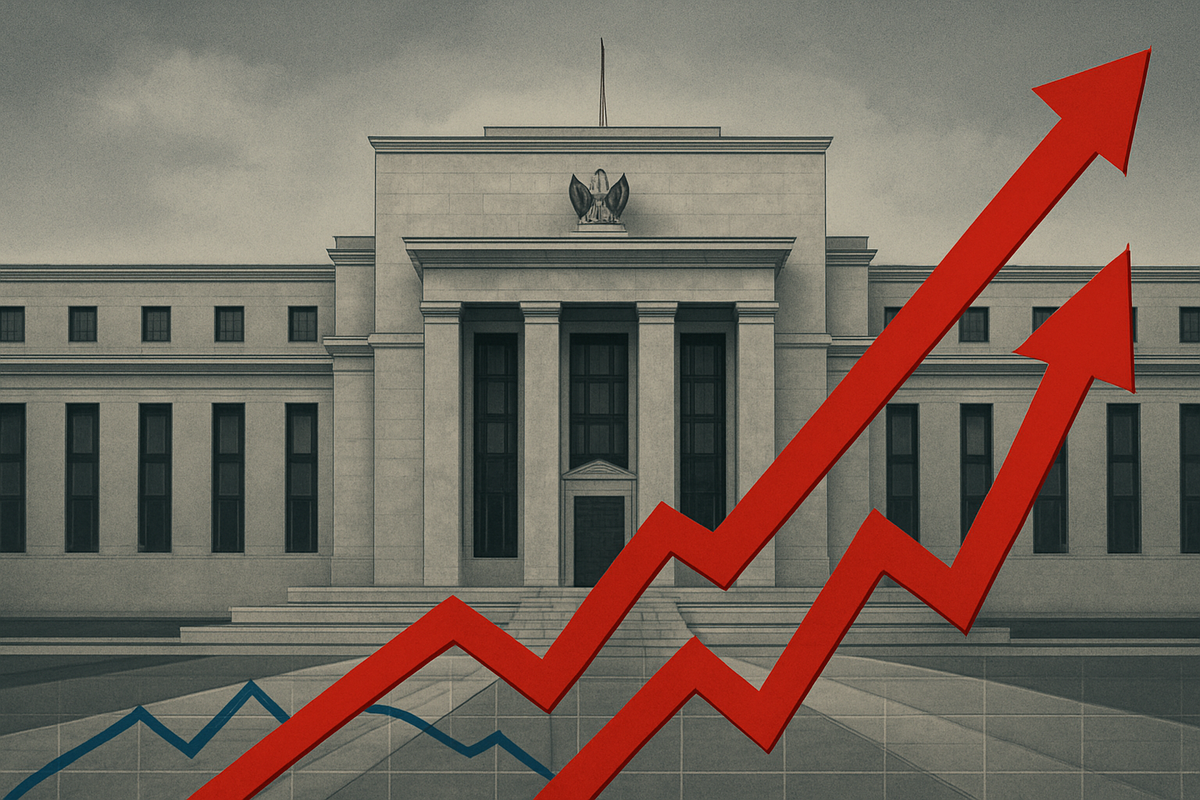
Washington D.C. – November 14, 2025 – The Federal Reserve has adopted an increasingly hawkish stance in recent weeks, with key officials signaling strong opposition to a December 2025 interest rate cut. This pivot has dramatically recalibrated market expectations, pushing back hopes for immediate monetary easing and ushering in a "higher for longer" interest rate environment. The shift is primarily driven by persistent inflation concerns, a surprisingly resilient economy, and a critical data void caused by a recent government shutdown.
The immediate implication is a sustained period of elevated borrowing costs for businesses and consumers, likely dampening spending and investment across the economy. Market sentiment has turned decidedly cautious, with equities experiencing sell-offs and investors rotating towards safer assets. The internal divisions within the Federal Open Market Committee (FOMC) further compound the uncertainty, making the future path of monetary policy highly data-dependent and contentious.
Detailed Coverage: Fed's Hawkish Pivot and Market's Uneasy Reaction
The Federal Reserve's journey to its current hawkish position has been a complex interplay of economic data, official communications, and unforeseen disruptions. While the Fed initiated an easing cycle with 25-basis-point rate cuts in September and October 2025, bringing the federal funds rate to a range of 3.75%-4.00%, the tone shifted dramatically after the October meeting.
Timeline of the Shift:
- September 2025 Rate Cut: The first rate cut since December 2024, largely anticipated and fueled by a Consumer Price Index (CPI) report showing less-than-expected inflation.
- October 2025 Meeting and Hawkish Tone: Another 25-basis-point cut was delivered, but Fed Chair Jerome Powell's post-meeting commentary struck an unexpectedly hawkish chord. He explicitly stated that a December cut was "far from a foregone conclusion" and acknowledged "strongly different views" within the FOMC.
- Government Shutdown Impact: A prolonged 43-day U.S. government shutdown significantly disrupted the release of crucial economic data, including October's employment and inflation figures. This data blackout left the Fed "flying blind," contributing to its cautious outlook.
- Persistent Inflation: Throughout this period, inflation remained "somewhat elevated," with CPI data rising to 3% in September 2025, consistently above the Fed's 2% target.
Specific Statements from Key Officials:
- Jerome Powell (Fed Chair): Emphasized the uncertainty around future rate adjustments and acknowledged "strongly differing views" within the committee.
- Raphael Bostic (Atlanta Fed President): A consistent "mild hawk," he explicitly opposed a December rate cut, citing persistent inflation risks and believing inflation to be the greater risk to the U.S. economy.
- Neel Kashkari (Minneapolis Fed President): Shifted his stance, stating he did not support the October rate cut and was "undecided" about December, citing the economy's unexpected resilience and inflation around 3% being "still too high."
- Jeffrey Schmid (Kansas City Fed President): Dissented against the October rate cut, advocating for no change.
- Alberto Musalem (St. Louis Fed President): Warned against easing too quickly with inflation still above target.
- Beth Hammack (Cleveland Fed President): Stated that monetary policy needs to remain "somewhat restrictive."
- Susan Collins (Boston Fed President):): Explicitly opposes further rate cuts, seeing a "relatively high bar" for additional easing.
Initial Market Reactions (as of 11/14/2025): The hawkish shift has triggered significant market volatility:
- Equity Performance: U.S. stock markets experienced a notable downturn. On November 13, 2025, the Nasdaq Composite plunged between 1.7% and 2%, the S&P 500 fell 1.1%, and the Dow Jones Industrial Average lost 0.8%. High-growth tech stocks and AI-linked companies like Nvidia (NASDAQ: NVDA), Broadcom (NASDAQ: AVGO), and Alphabet (NASDAQ: GOOGL) bore the brunt of the sell-off, with some AI stocks retracing 7% to 10% from recent highs.
- Bond Yields: Treasury yields climbed, with the U.S. 10-year Treasury yield rising to around 4.10%-4.12%, reflecting expectations for sustained higher rates.
- Safe-Haven Assets: Gold (COMEX: GC=F) demonstrated resilience, reclaiming the $4,200 level, while Bitcoin (CRYPTO: BTC) slid below $100,000, extending its loss to over 20% since early October.
Company Impact: Winners and Losers in a Higher-for-Longer World
The Federal Reserve's commitment to a "higher for longer" interest rate environment will inevitably create a clear delineation of winners and losers across various sectors of the public market.
Sectors Likely to Win:
- Banking and Financials: Banks, insurance companies, and brokerage firms generally benefit from higher interest rates. The wider spread between what they pay on deposits and what they earn on loans (net interest margin) typically expands, boosting profitability. Large banks like JPMorgan Chase (NYSE: JPM), Bank of America (NYSE: BAC), and Goldman Sachs Group (NYSE: GS) are well-positioned, as are firms like Charles Schwab (NYSE: SCHW) which have strategically managed their cash holdings.
- Companies with Strong Balance Sheets and Stable Cash Flows: Businesses with low debt and robust cash generation are more resilient. They are less reliant on expensive borrowing for operations or expansion and can even capitalize on opportunities by acquiring struggling competitors. Major tech players like Apple (NASDAQ: AAPL) and Microsoft (NASDAQ: MSFT), despite being in a rate-sensitive sector, benefit from their substantial cash reserves, earning higher yields on their investments.
Sectors Likely to Lose:
- Real Estate: This sector is highly vulnerable. Higher mortgage rates deter homebuyers, reducing sales volumes and property valuations. Commercial real estate (CRE) faces significant challenges, particularly office spaces, due to refinancing difficulties and the shift to hybrid work. Homebuilders like D.R. Horton (NYSE: DHI) and Lennar Corporation (NYSE: LEN) could see dampened demand.
- Technology (Growth Stocks): Tech companies, especially those with future-heavy earnings streams, are negatively impacted. Higher discount rates reduce the present value of future cash flows, leading to lower valuations. Many startups also rely on external funding, which becomes more expensive and scarcer. Companies heavily invested in AI, such as Nvidia (NASDAQ: NVDA) and Palantir Technologies (NYSE: PLTR), have already experienced profit-taking.
- Consumer Discretionary: This sector, selling non-essential goods and services, is highly sensitive to consumer spending power. Higher borrowing costs for credit cards and auto loans reduce disposable income, leading to a pullback in spending on items like cars, appliances, dining out, and luxury goods. Retailers such as Kohl's Corp. (NYSE: KSS) and Home Depot, Inc. (NYSE: HD) could face headwinds, while fast-casual chains like Chipotle Mexican Grill (NYSE: CMG) have already seen slowing sales growth.
- Highly Leveraged Companies: Across all sectors, companies with substantial debt burdens will face increased debt servicing costs, squeezing profitability and limiting investment capacity.
Wider Significance: Global Ripples and Historical Echoes
The Federal Reserve's hawkish stance extends its influence far beyond U.S. borders, weaving into broader global trends and echoing historical monetary policy battles.
Broader Industry Trends:
- Global Monetary Policy: A stronger U.S. dollar, a typical consequence of higher interest rates, makes dollar-denominated commodities more expensive internationally, potentially dampening global demand and affecting commodity prices across the board. The Fed's actions can also limit credit availability to developing markets.
- Inflation Fight: The Fed's hawkishness is a direct continuation of its fight against persistent inflation, which has remained above its 2% target. Concerns about potential tariff policies from the Trump administration further complicating inflation in 2025 are on the Fed's radar.
- Economic Growth: While some predict continued U.S. economic growth in 2025, the pace is expected to slow. Higher borrowing costs deter business investment and expansion, creating a "chilling effect." The labor market is also expected to cool gradually.
Ripple Effects on Competitors and Partners:
- Rate-Sensitive Sectors: Construction and real estate face increased mortgage costs and slower demand. Retail and consumer goods businesses will likely experience reduced consumer spending.
- Technology and Start-Ups: Tighter capital markets will make funding harder to secure, potentially leading to more startup failures, as seen with the trucking startup Convoy.
- Financial Services: While initially benefiting from wider net interest margins, banks may face higher funding costs and a less optimistic outlook for net interest income growth.
- Commodity Markets: The strengthening dollar and increased opportunity cost of non-yielding assets have already led to declines in precious metals prices.
- Business Investment: Companies are becoming more cautious, delaying or shelving growth projects and prioritizing those with quicker returns.
Regulatory or Policy Implications Beyond Interest Rates:
- Trade Policy and Tariffs: The potential for new tariffs to raise consumer prices and impact economic growth presents a dilemma for the Fed, which might have to choose between fighting inflation and supporting the labor market.
- Financial Stability: Regulators are intensifying focus on financial institutions' risk management, including interest rate risk, climate-related events, and third-party dependencies, particularly in the growing non-bank financial institutions (NBFIs) sector.
- Technology Regulation: Scrutiny of Artificial Intelligence (AI) and cybersecurity is expected to remain intense, as regulators grapple with rapid technological changes.
Historical Precedents: The current period draws parallels to the Volcker Era (late 1970s - early 1980s), when the Fed aggressively raised rates to combat stagflation, albeit at the cost of a severe recession. Internal Fed divisions are also not new, echoing debates during the Great Inflation and reinforcing the importance of the Treasury-Fed Accord of 1951, which established the Fed's independence in monetary policy.
What Comes Next: Navigating Uncertainty
The Federal Reserve's hawkish stance sets the stage for a period of continued uncertainty and necessitates strategic adaptations for both businesses and investors. The path forward for monetary policy and economic performance will be a delicate balance.
Monetary Policy Outlook:
- Short-Term (Late 2025 - Early 2026): The "higher for longer" narrative will dominate. A December 2025 rate cut is highly unlikely, with probabilities hovering around 50%. The Fed will remain highly data-dependent, particularly given the recent data blackout. The conclusion of quantitative tightening (QT) by December 1, 2025, will shift to a more passive balance sheet approach, but financial conditions are expected to remain tight.
- Long-Term (2026 and Beyond): Gradual easing is possible later in 2026 if inflation shows definitive signs of moving towards the 2% target. Forecasts from Goldman Sachs and Scotiabank suggest a few 25-basis-point cuts throughout 2026, bringing the terminal rate to a potentially higher "neutral" level than previously envisioned.
Economic Performance:
- Short-Term: Expect slower economic growth (projected 1.9% real GDP growth in 2025), persistent inflation (core PCE forecast at 2.5% in 2025), and a further softening of the labor market (unemployment rate projected at 4.3% in 2025). The housing market will remain constrained.
- Long-Term: The key is whether the Fed achieves a "soft landing." If successful, growth could accelerate in late 2026, supported by consumer spending and potential fiscal stimulus. However, the risk of prolonged stagnation or stagflation (persistent inflation with sluggish growth) remains.
Strategic Pivots for Businesses and Investors:
- Businesses: Must prioritize cost management, operational efficiency, and debt reduction. Capital expenditure plans should be re-evaluated, focusing on projects with higher, quicker returns. Supply chain resilience and careful pricing strategies will be crucial.
- Investors: Diversification and a focus on safe-haven assets (e.g., gold) are prudent. Re-evaluate risk exposure in high-valuation growth sectors. Value stocks, dividend-paying stocks, and companies with strong fundamentals will become more appealing. Active management in credit markets is advisable. Closely monitor Fed communications and incoming economic data.
Potential Scenarios and Outcomes:
- "Hawkish Hold" leading to a Delayed Soft Landing (Most Likely): The Fed holds rates steady, allowing inflation to cool gradually. Economic growth decelerates but avoids a severe recession. Markets experience initial volatility, followed by a gradual recovery as disinflation becomes clearer.
- "Hard Landing" / Recession: The Fed's policy proves too restrictive, or unforeseen shocks occur. A significant economic downturn ensues, forcing the Fed to cut rates aggressively later. This would lead to a sustained bear market and a surge in safe-haven demand.
- "Stagflation": Persistent high inflation coexists with sluggish economic growth. The Fed is caught in a bind, unable to ease without reigniting inflation. This would be a challenging environment for most asset classes.
Comprehensive Wrap-up: A Cautious Path Ahead
The Federal Reserve's hawkish stance and strong opposition to a December 2025 rate cut mark a significant shift in the monetary policy landscape. The central bank's unwavering focus on combating persistent inflation, coupled with a resilient yet softening economy and the complicating factor of a government shutdown, has firmly established a "higher for longer" interest rate outlook.
Key Takeaways:
- Market expectations for a December 2025 rate cut have been drastically reduced.
- The Fed prioritizes inflation control, even at the cost of slower economic growth.
- Internal divisions within the FOMC create significant policy uncertainty.
- The data blackout from the government shutdown exacerbates the challenge of accurate economic assessment.
Market Moving Forward: Expect continued market volatility and a prevailing "risk-off" sentiment. Equities, especially growth and tech stocks, will likely face ongoing pressure. Bond yields are expected to remain elevated, and the U.S. dollar may strengthen further. Investors will need to be agile, focusing on fundamentally strong companies and defensive sectors.
Significance and Lasting Impact: This period represents a pivotal moment for monetary policy, potentially delaying the return to a more accommodative stance. The lasting impact could be a prolonged era of elevated borrowing costs, influencing consumer behavior, business investment, and the housing market for an extended period. The Fed's actions will shape the economic trajectory for years to come, with the potential for either a difficult but successful disinflation or a more challenging environment of persistent inflation and slower growth.
What Investors Should Watch For:
- Inflation Data: The core PCE and CPI reports will be critical once the data blackout is resolved.
- Labor Market Reports: Unemployment rates, job gains, and wage growth.
- Federal Reserve Communications: Speeches and statements from Fed officials, particularly Chair Powell.
- Resolution of Data Blackout: The release of delayed economic data for October.
- Government Policy: Developments regarding tariffs and fiscal stimulus.
- Global Economic Stability: External factors influencing the U.S. economy.
This content is intended for informational purposes only and is not financial advice





